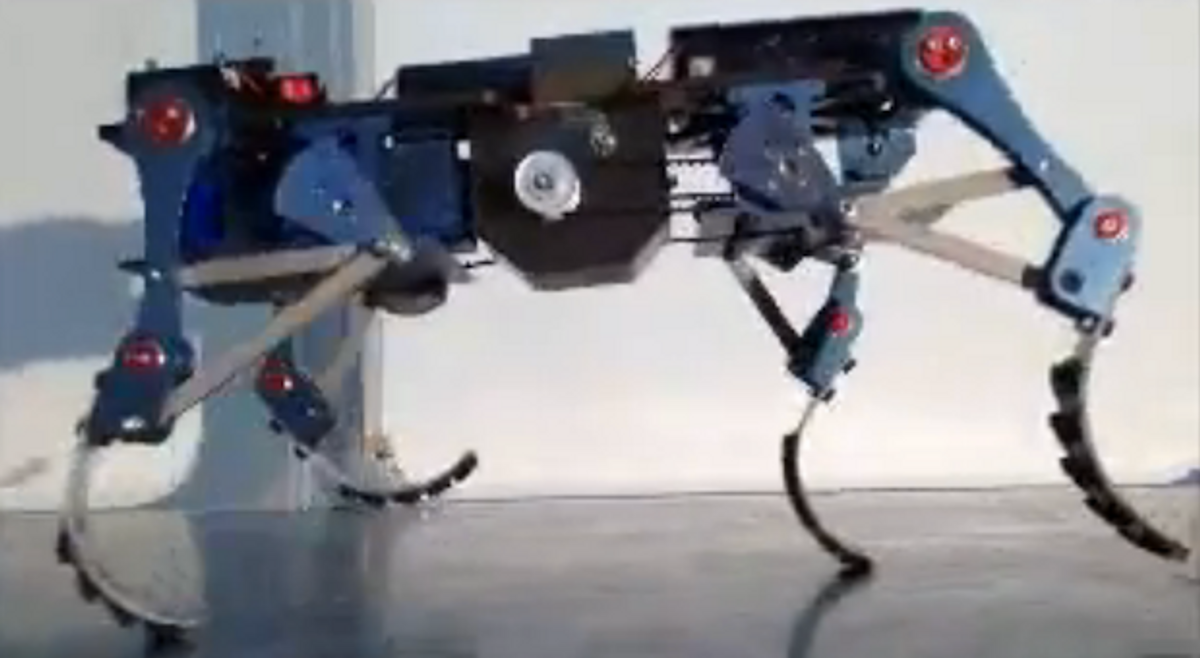Now, you may be asking why we need quadruped robots and, in particular, cat-inspired ones. The creators of the Cheetaroid, a team from Sogang University's Robotic Systems Control Laboratory, led by Professor Kyoungchul Kong, are envisioning different applications. They illustrate those in the image below, which shows how Cheetaroid could be used to assist firefighters, soldiers, disabled individuals, and—well, we're not exactly sure what's going on in the lower right image but we wouldn't want to be the guy in the bite suit.
Lately, most quadruped projects have focused on building faster and more efficient robots. One of the design challenges is choosing which actuators to use in place of the leg muscles. The actuators, which can take the form of electric motors, hydraulics, or even air-powered pneumatics, have to be relatively small and lightweight, yet also fast and powerful. That's a difficult combination to achieve, leading some teams to design their own hybrid systems in an attempt to get the best of both worlds.
For its robot, the Cheetaroid team decided to build its own direct-drive DC linear actuator. The idea is that this kind of actuator has lower friction and backlash than geared motors, and since it doesn't require gear reducers (which are used to amplify torque) they are more energy efficient and precise. The challenge is that by using linear actuators, the control system must account for changes in overall joint torque, which depends on the joint's angle, during locomotion.
After running some simulations to determine the optimum actuator requirements, the team set out to design the device itself. Most linear actuators contain a steel yoke to concentrate the magnetic fields that ultimately push and pull the moving elements attached to the leg joints. For their new actuator, the researchers ditched the yoke to save weight and covered the electromagnetic coils with dual-layer cores to retain much of the magnetic field and force capacity. The images below show the overall design and how they plan to integrate the actuators into the robot:
So far the team has built and tested one of the robot's hind legs and found that it performed in line with their simulations. The next step will be simulating the rest of the body and determine whether Cheetaroid can walk and gallop. Professor Kong says that, in parallel with the mechanical design, his team is working on effective control algorithms to change between gaits.
The Cheetaroid remains a work in progress, and we look forward to seeing videos of the completed robot taking its first steps. In the mean time, the researchers have been exploring alternative designs. One of them is a Cheetaroid version that uses a single motor to power all four limbs:
The South Korean team, which included Byeonghun Na, Hyunjin Choi, and Professor Kong, describe their work in the paper "Design of a Direct-Driven Linear Actuator for Development of a Cheetaroid Robot," presented at the 2013 IEEE International Conference on Robotics and Automation. They acknowledge Seokjin Kim for his assistance in designing the actuator.
And finally, a note to all researchers developing fast-running quadrupeds: If it's not too much to ask, may we suggest that all teams get together for a Big Cat Robot Race?







